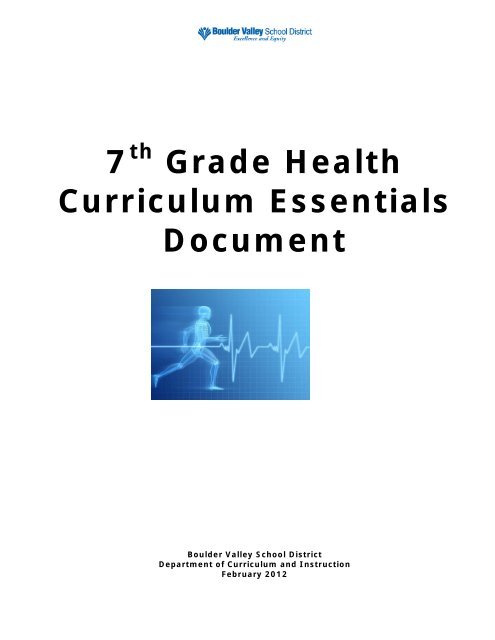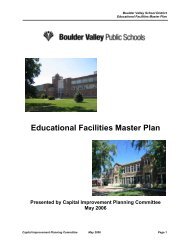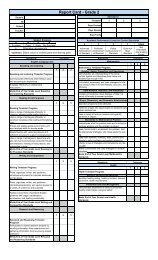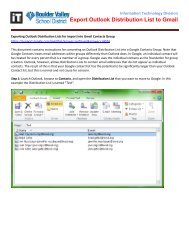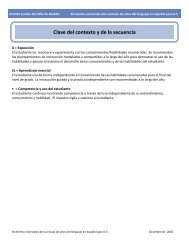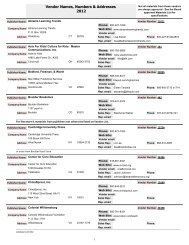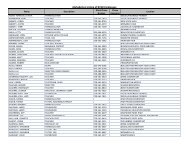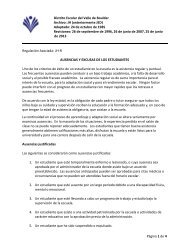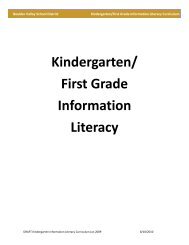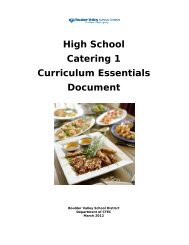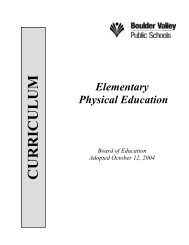7th Grade Health Curriculum - Boulder Valley School District
7th Grade Health Curriculum - Boulder Valley School District
7th Grade Health Curriculum - Boulder Valley School District
You also want an ePaper? Increase the reach of your titles
YUMPU automatically turns print PDFs into web optimized ePapers that Google loves.
7 th <strong>Grade</strong> <strong>Health</strong><strong>Curriculum</strong> EssentialsDocument<strong>Boulder</strong> <strong>Valley</strong> <strong>School</strong> <strong>District</strong>Department of <strong>Curriculum</strong> and InstructionFebruary 2012
IntroductionPurposeThe purpose of a quality physical education program is to guide students in the process of becomingphysically active for a lifetime. Physical education is a component of education that takes placethrough movement. In physical education, as in all academic areas, students must learn the basicskills be able to demonstrate throughout their preschool through twelfth-grade experience.1. Movement Competence and Understanding (Physical Education)Includes motor skills and movement patterns that teach skill and accuracy in a variety of routines,games, and activities that combine skills with movement; demonstrates the connection between bodyand brain function; and creates patterns for lifelong physical activity.2. Physical and Personal Wellness (Shared Standard)Includes physical activity, healthy eating, and sexual health and teaches lifelong habits and patternsfor a fit, healthy, and optimal childhood and adulthood; examines society, media, family, and peerinfluence on wellness choices; practices decision-making and communication skills for personalresponsibility for wellness; and identifies the consequences of physical inactivity, unhealthy eating, andearly sexual activity. Includes health promotion and disease prevention, and teaches responsibility andskills for personal health habits as well as behavior and disease prevention; sets personal goals foroptimal health; examines common chronic and infectious diseases and causes; and recognizes thephysical, mental, and social dimensions of personal health.3. Emotional and Social Wellness (Shared Standard)Includes mental, emotional, and social health skills to recognize and manage emotions, develop careand concern for others, establish positive relationships, make responsible decisions, handle challengingsituations constructively, resolve conflicts respectfully, manage stress, and make ethical and safechoices; examines internal and external influences on mental and social health; and identifies commonmental and emotional health problems and their effect on physical health.4. Prevention and Risk Management (Shared Standard)Includes alcohol, tobacco, and other drug prevention; violence prevention; and safety; teaches skills toincrease safe physical and social behavior in at home, in school, in the community, and in personalrelationships; provides specific knowledge on avoidance of intentional and unintentional injuries; andpractices decision-making and communication skills to avoid drug use, bullying, and dating violence.Students integrate and apply the skills learned in physical education to their everyday life. In addition,numerous benefits result from participating in a quality physical education program such as:learning how to live an active and healthy lifestyle, proper nutrition, skill development, improvedphysical fitness, reinforcement of other subjects, goal setting, self-discipline, leadership andcooperation, stress reduction, enhanced self-efficacy, and strengthened peer relationships.The physical education setting also provides a unique opportunity for students to develop anunderstanding and respect for differences among people. Cultural and global awareness can beenhanced through participation in physical activity, sports, dance and/or rhythms from other cultures.3/13/2012 BVSD <strong>Curriculum</strong> Essentials 2
21 st Century Skills and Readiness Competencies inComprehensive <strong>Health</strong> and Physical EducationColorado's Description of 21st Century SkillsColorado’s description of 21 st century skills is a synthesis of the essential abilities students must applyin our rapidly changing world. Today’s students need a repertoire of knowledge and skills that aremore diverse, complex, and integrated than any previous generation. Comprehensive health andphysical education are inherently demonstrated in each of Colorado’s 21 st century skills, as follows:Critical Thinking and Reasoning<strong>Health</strong> and physical education are disciplines grounded in critical thinking and reasoning. Developingand maintaining lifelong wellness habits involves decision-making and communication skills thatsometimes can determine life-and-death outcomes. The skills and knowledge gained in health andphysical education provide the structure that makes it possible to prevent risk behavior and adopthealthy lifestyles. Without good health and physical activity, critical thinking and reasoning arecompromised.Information LiteracyThe disciplines of health and physical education equip students with the tools and habits of mind toorganize and interpret a multitude of rapidly changing information resources. Students who are literatein health and physical education can analyze effectively primary and secondary sources, detect bias,use learning tools, including technology and media, and clearly communicate thoughts using soundreasoning.CollaborationThe health and physical education content areas directly involve students in teams, problem-solvinggroups, and community connections to support the overall health of the individual and the community.Students offer ideas, strategies, solutions, justifications, and proofs for others to evaluate. In turn,students use feedback to improve performance and interpret and evaluate the ideas, strategies,solutions, and justifications of others.Self-DirectionUnderstanding and participating in health and physical education requires a productive disposition,curiosity, personal motivation, and self-direction. <strong>Health</strong> and physical education are more than passivelearning. Individual active participation, practice, and competence are underlying principles of thesecontent areas.InventionThe health and physical education disciplines are a dynamic set of content area disciplines, everexpanding with new research, ideas, and understandings. Invention is the key element of theexpansion as students make and test theories and skills, create and use tools, search for patterns andthemes, and make connections among ideas, strategies, and solutions.3/13/2012 BVSD <strong>Curriculum</strong> Essentials 3
Colorado’s Description for <strong>School</strong> Readiness(Adopted by the State Board of Education, December 2008)<strong>School</strong> readiness describes both the preparedness of a child to engage in and benefit from learningexperiences, and the ability of a school to meet the needs of all students enrolled in publicly fundedpreschools or kindergartens. <strong>School</strong> readiness is enhanced when schools, families, and communityservice providers work collaboratively to ensure that every child is ready for higher levels of learning inacademic content.Colorado’s Description of Postsecondary and Workforce Readiness(Adopted by the State Board of Education, June 2009)Postsecondary and workforce readiness describes the knowledge, skills, and behaviors essential forhigh school graduates to be prepared to enter college and the workforce and to compete in the globaleconomy. The description assumes students have developed consistent intellectual growth throughouttheir high school career as a result of academic work that is increasingly challenging, engaging, andcoherent. Postsecondary education and workforce readiness assumes that students are ready and ableto demonstrate the following without the need for remediation: Critical thinking and problem-solving;finding and using information/information technology; creativity and innovation; global and culturalawareness; civic responsibility; work ethic; personal responsibility; communication; and collaboration.How These Skills and Competencies are Embedded in the Revised StandardsThree themes are used to describe these important skills and competencies and are interwoventhroughout the standards: inquiry questions; relevance and application; and the nature of eachdiscipline. These competencies should not be thought of stand-alone concepts, but should beintegrated throughout the curriculum in all grade levels. Just as it is impossible to teach thinking skillsto students without the content to think about, it is equally impossible for students to understand thecontent of a discipline without grappling with complex questions and the investigation of topics.Inquiry Questions – Inquiry is a multifaceted process requiring students to think and pursueunderstanding. Inquiry demands that students (a) engage in an active observation and questioningprocess; (b) investigate to gather evidence; (c) formulate explanations based on evidence; (d)communicate and justify explanations, and; (e) reflect and refine ideas. Inquiry is more than hands-onactivities; it requires students to cognitively wrestle with core concepts as they make sense of newideas.Relevance and Application – The hallmark of learning a discipline is the ability to apply theknowledge, skills, and concepts in real-world, relevant contexts. Components of this include solvingproblems, developing, adapting, and refining solutions for the betterment of society. The application ofa discipline, including how technology assists or accelerates the work, enables students to more fullyappreciate how the mastery of the grade level expectation matters after formal schooling is complete.Nature of Discipline – The unique advantage of a discipline is the perspective it gives the mind tosee the world and situations differently. The characteristics and viewpoint one keeps as a result ofmastering the grade level expectation is the nature of the discipline retained in the mind’s eye.3/13/2012 BVSD <strong>Curriculum</strong> Essentials 4
7 th <strong>Grade</strong> <strong>Health</strong> OverviewCourse Description<strong>Health</strong> Education in seventh grade is based ondeveloping skills in relation to age appropriate healthtopics. By developing skills related to effectivelyaccessing health resources, communicating, analyzingpeer and media influences, goal setting, decisionmaking, and health advocacy, students in BVSD will beable to achieve and maintain optimal wellness.Topics at a Glance• Factors that influence eatingbehaviors and physical activity• <strong>Health</strong>y food choices• Influences on sexual decisionmaking• Define STD’s• Identify healthy relationships• Stress management• Communicate feelings• Consequences of drug useAssessments• Observation Participation• Performance Tasks Rubrics• Conferencing Portfolio• Growth Over TimeStandard2. Physicaland PersonalWellness3. Emotionaland SocialWellness4.Preventionand RiskManagementBig Ideas in Seventh <strong>Grade</strong>(<strong>Grade</strong> Level Expectations)1. Analyze factors that influence healthyeating behaviors2. Demonstrate the ability to make healthyfood choices in a variety of settings3. Compare and contrast healthy andunhealthy relationships (family, peer, anddating)4. Analyze the internal and external factorsthat influence sexual decision-making andactivity5. Define sexually transmitted diseases(STDs), including humanimmunodeficiency virus (HIV) andacquired immune deficiency syndrome(AIDS)1. Demonstrate effective communicationskills to express feelings appropriately2. Develop self-management skills to preventand manage stress1. Analyze the consequences of usingalcohol, tobacco and other drugs2. Demonstrate safety procedures for avariety of situationsUnifying Theme“What it takes to be healthy”Organizing Concepts:• Recognizing signs, symptoms,and/or Consequences• Analyzing family, peers, media,culture, perceived norms, and/orinternal influences• Communicating limits andconcerns• Strategizing for self managementof safety• and health<strong>Health</strong> Education Standards Support:• Analyzing Influences• Accessing Information - literacy• Communication skills for personalneeds• Self Management for ViolencePrevention• House Bill 1292 – Sexual <strong>Health</strong>Standards3/13/2012 BVSD <strong>Curriculum</strong> Essentials 5
2. Physical and Personal WellnessIncludes physical activity, healthy eating, and sexual health and teaches lifelong habits andpatterns for a fit, healthy, and optimal childhood and adulthood; examines society, media, family,and peer influence on wellness choices; practices decision-making and communication skills forpersonal responsibility for wellness; and identifies the consequences of physical inactivity,unhealthy eating, and early sexual activity. Includes health promotion and disease prevention, andteaches responsibility and skills for personal health habits as well as behavior and diseaseprevention; sets personal goals for optimal health; examines common chronic and infectiousdiseases and causes; and recognizes the physical, mental, and social dimensions of personalhealth.Prepared GraduatesThe prepared graduate competencies are the preschool through twelfth-grade concepts and skillsthat all students who complete the Colorado education system must master to ensure their successin a postsecondary and workforce setting.Prepared Graduates in the Physical and Personal Wellness standard are:‣ Apply knowledge and skills to engage in lifelong healthy eating‣ Apply knowledge and skills necessary to make personal decisions that promote healthyrelationships and sexual and reproductive health (NOT ADDRSSED AT THIS GRADELEVEL)‣ Apply knowledge and skills related to health promotion, disease prevention, and healthmaintenance3/13/2012 BVSD <strong>Curriculum</strong> Essentials 6
in which they can be found (vitamin C/citrus fruits,calcium/dairy products and leafy greens)m. Examines myths and misperceptions regarding dieting,exercise, healthy body weight, and dietarysupplements/performance enhancersn. Describes the spectrum of diets and the perceived advantages/ disadvantages of each (vegetarian, vegan, organic, locallysourced, gluten free casein free)o. Describes barriers to healthy eating such as cost, seasonalavailability of foods, and educationNature of Discipline:1. <strong>Health</strong>ful living requires an individual to analyze all availableinformation about good nutrition and to use suchinformation to make healthy choices, even when doing someans breaking comfortable habits.3/13/2012 BVSD <strong>Curriculum</strong> Essentials 8
Content Area: Comprehensive <strong>Health</strong> - Seventh <strong>Grade</strong>Standard: 2. Physical and Personal Wellness in <strong>Health</strong>Prepared Graduates:Apply knowledge and skills to engage in lifelong healthy eating<strong>Grade</strong> Level ExpectationConcepts and skills students master:2. Demonstrate the ability to make healthy food choices in a variety of settingsEvidence Outcomes21 st Century Skills and Readiness CompetenciesStudents can:a. Develop strategies for making healthier food and beveragechoices in a variety of settings such as eating out, at home,with friends, or at schoolb. Demonstrate interpersonal skills that deal with negativeinfluences on healthy eatingInquiry Questions:1. What is a healthy weight?2. How can a healthy diet for one person be unhealthy foranother?3. Why do people on restrictive diets often end up gaining moreweight?Relevance and Application:1. Food choices have an impact on the environment.2. Individuals must determine for themselves which foodchoices lead to their optimal health and weight goals.Nature of Discipline:1. <strong>Health</strong>y eating can influence physical, emotional, andenvironmental health.3/13/2012 BVSD <strong>Curriculum</strong> Essentials 9
Content Area: Comprehensive <strong>Health</strong> - Seventh <strong>Grade</strong>Standard: 2. Physical and Personal Wellness in <strong>Health</strong>Prepared Graduates:Apply knowledge and skills necessary to make personal decisions that promote healthy relationships and sexual and reproductivehealth<strong>Grade</strong> Level ExpectationConcepts and skills students master:3. Compare and contrast healthy and unhealthy relationships (family, peer, and dating)Evidence Outcomes21 st Century Skills and Readiness CompetenciesStudents can:a. Describe the characteristics of healthy relationships, anddiscuss factors that support and sustain themb. Explain the purpose of friendship in different stages of the lifecycle, and describe how friends can support one another inmaking healthy decisionsc. Describe effective strategies for dealing with difficultrelationships with family members, peers, and boyfriends orgirlfriendsd. Describe the emotional effects of breaking up in a datingrelationshipe. Explain the role of dating in personal growthf. Explains connections between developing and maintainingrelationships, feeling valued and connected, and self-esteemInquiry Questions:1. What is "dating"?2. How might "unhealthy" family and peer relationshipsinfluence future dating relationships?Relevance and Application:1. Various cultures date and select life partners differently.2. Technological advances provide increased opportunities todevelop relationships anytime and anyplace with aworldwide audience.3. <strong>Health</strong>y relationships require many things of both people.Nature of Discipline:1. Understanding the various aspects of human relationshipsassists in making healthy choices.3/13/2012 BVSD <strong>Curriculum</strong> Essentials 10
Content Area: Comprehensive <strong>Health</strong> - Seventh <strong>Grade</strong>Standard: 2. Physical and Personal Wellness in <strong>Health</strong>Prepared Graduates:Apply knowledge and skills necessary to make personal decisions that promote healthy relationships and sexual and reproductivehealth<strong>Grade</strong> Level ExpectationConcepts and skills students master:4. Analyze the internal and external factors that influence sexual decision-making and activityEvidence Outcomes21 st Century Skills and Readiness CompetenciesStudents can:a. Describe a variety of external influences such as parents, themedia, culture, peers, and society that affect sexual decisionmakingand sexual activityb. Describe how internal influences such as curiosity, hormones,interests, desires, fears, and feelings affect sexual decisionmakingand activityc. Describe how personal, peer, and family values influencedecisions about sexual and reproductive healthd. Analyze the discrepancies between perceived and actualsexual activitye. Describes physical, emotional, and social changes that takeplace during puberty and adolescencef. Explains ways adolescent physical, mental, and social growthand development influence behaviors, wants, and needsg. Analyzes reasons why some adolescent health and behaviorproblems may emerge as a result of accelerated/delayeddevelopmentInquiry Questions:1. How do I discern media and cultural messages that supportoptimal health versus those that undermine optimal healthregarding sexual decision-making and activity?2. How does what my family thinks about sexual activity affectme?3. How does what my friends and peers think about sexualactivity affect me?Relevance and Application:1. The internet and other forms of media influence sexualdecision-making.2. Families, peers, the media, culture, and society influencewhat a person thinks about people who have infectious orchronic diseases, such as HIV infection, AIDS, and cancer.3. Families, peers, the media, culture, and society influencewhat one thinks about attractiveness and relationships.Nature of Discipline:1. External factors and situations that present themselves aswell as internal factors—such as hormones, curiosity, desire,attraction, fear, and other feelings—may influence a person’shealthy decision-making and behavior.3/13/2012 BVSD <strong>Curriculum</strong> Essentials 11
Content Area: Comprehensive <strong>Health</strong> - Seventh <strong>Grade</strong>Standard: 2. Physical and Personal Wellness in <strong>Health</strong>Prepared Graduates:Apply knowledge and skills necessary to make personal decisions that promote healthy relationships and sexual and reproductivehealth<strong>Grade</strong> Level ExpectationConcepts and skills students master:5. Define sexually transmitted diseases (STDs), including human immunodeficiency virus (HIV) and acquired immune deficiencysyndrome (AIDS)Evidence Outcomes21 st Century Skills and Readiness CompetenciesStudents can:a. Describe the effects of HIV infection on the bodyb. Explain how HIV is and is not contractedc. Define common STDsd. Describes causes, symptoms, short‐ term, and long‐ termeffects of communicable and non‐ communicable diseasese. Identifies and describes behaviors that reduce the risk ofcommunicable andnon‐ communicable diseases such as obesity, diabetes, heartdisease, cancers, hepatitis, STD’s, and HIVf. Differentiates between communicable and non‐ communicablediseasesInquiry Questions:1. Is it safe to be around people who are infected with HIV?Why or why not?2. Why is HIV/AIDS generally thought to be more dangerousthan other STDs?Relevance and Application:1. The human immunodeficiency virus affects the body'simmune.2. Universal precautions are recommended for anyone whocomes into contact with bodily fluids.Nature of Discipline:1. Tolerance, appreciation, and understanding of the conditionsof others demonstrate humanity and empathy.2. There are many different kinds of sexually transmitteddiseases. Some can be treated and/or cured and somecannot, and all can lead to serious health complications.3/13/2012 BVSD <strong>Curriculum</strong> Essentials 12
3. Emotional and Social WellnessIncludes mental, emotional, and social health skills to recognize and manage emotions, developcare and concern for others, establish positive relationships, make responsible decisions, handlechallenging situations constructively, resolve conflicts respectfully, manage stress, and makeethical and safe choices; examines internal and external influences on mental and social health;and identifies common mental and emotional health problems and their effect on physical health.Prepared GraduatesThe prepared graduate competencies are the preschool through twelfth-grade concepts and skillsthat all students who complete the Colorado education system must master to ensure their successin a postsecondary and workforce setting.Prepared Graduates in the Emotional and Social Wellness standard are:‣ Utilize knowledge and skills to enhance mental, emotional, and social well-being3/13/2012 BVSD <strong>Curriculum</strong> Essentials 13
Content Area: Comprehensive <strong>Health</strong> - Seventh <strong>Grade</strong>Standard: 3. Emotional and Social Wellness in <strong>Health</strong>Prepared Graduates:Utilize knowledge and skills to enhance mental, emotional, and social well-being<strong>Grade</strong> Level ExpectationConcepts and skills students master:1. Demonstrate effective communication skills to express feelings appropriatelyEvidence Outcomes21 st Century Skills and Readiness CompetenciesStudents can:a. Demonstrate the ability to engage in active listeningb. Practice the use of “I” statementsc. Demonstrate negotiation skills to support the healthyexpression of personal needsd. Demonstrate the ability to state personal needs and articulatelimitse. Practice verbal and nonverbal ways to ask for help fromtrusted adults or friendsInquiry Questions:1. How will I know who to trust with my personal emotionalhealth issues?2. How can I keep my friends if I disagree with them?3. How can I express my feelings and concerns if I am shy orfeel embarrassed?4. How can I be a better listener?Relevance and Application:1. Hostage negotiators rely on using their verbal and nonverbalcommunications skills to diffuse dangerous situations2. Setting boundaries provides a framework for responsibledecision-making and can contribute to the development of apositive self-image.Nature of Discipline:1. Effective communication skills affect mental and socialhealth, and are life-long skills.3/13/2012 BVSD <strong>Curriculum</strong> Essentials 14
Content Area: Comprehensive <strong>Health</strong> - Seventh <strong>Grade</strong>Standard: 3. Emotional and Social Wellness in <strong>Health</strong>Prepared Graduates:Utilize knowledge and skills to enhance mental, emotional, and social well-being<strong>Grade</strong> Level ExpectationConcepts and skills students master:2. Develop self-management skills to prevent and manage stressEvidence Outcomes21 st Century Skills and Readiness CompetenciesStudents can:a. Compare and contrast positive and negative ways of dealingwith stressb. Define stressc. Identify personal stressorsd. Explain the body’s physical and psychological responses tostressful situationse. Develop personal strategies to deal with stressorsf. Practice strategies such as physical activity, relaxationtechniques, journaling, and talking with someone to reducestressg. Identifies ways in which life changes affect mentalhealth/emotional wellnessInquiry Questions:1. If you were angry all the time, how would your bodyrespond?2. If you were happy all the time, how would your bodyrespond?3. Why would it be important to know different ways tomanage stress effectively?4. Under what circumstances is stress a good thing?Relevance and Application:1. Attitude plays an important role in managing stress.2. Laughter is the best medicine.3. Personal stressors at home, with friends, in school and thecommunity, and in the environment can effect one’s feelingsand emotions.Nature of Discipline:1. <strong>Health</strong>y coping strategies exist to help people deal withstress in order to maintain emotional and physical health.3/13/2012 BVSD <strong>Curriculum</strong> Essentials 15
Content Area: Comprehensive <strong>Health</strong> - Seventh <strong>Grade</strong>Standard: 4. Prevention and Risk Management in <strong>Health</strong>Prepared Graduates:Apply knowledge and skills to make health-enhancing decisions regarding the use of alcohol, tobacco, and other drugs<strong>Grade</strong> Level ExpectationConcepts and skills students master:1. Analyze the consequences of using alcohol, tobacco, and other drugsEvidence Outcomes21 st Century Skills and Readiness CompetenciesStudents can:a. Examine the social, economic, health and cosmeticconsequences of alcohol, tobacco including chewing tobacco),and other drug use,b. Explain how alcohol, tobacco, and other drugs are addictivec. Explain family rules, school policies, and community lawsrelated to the sale and use of alcohol, tobacco, and otherdrugsd. Explain how alcohol, tobacco, and other drugs alter the bodyand the braine. Describe how exercise, nutrition, and positive relationshipscan mitigate the use of alcohol, tobacco, and other drugsf. Analyze the effects of alcohol, tobacco, and other substanceson a person’s ability to make decisionsg. Identifies BVSD and community alcohol and drug freeactivitiesh. Identifies community resources and services for substanceabuse prevention and interventioni. Describes situations in which one may encounter pressure touse tobacco, alcohol, and other drugsj. Demonstrates strategies to deal with peer pressure to usesubstancesInquiry Questions:1. Would people still use tobacco if it did not have an addictivequality?2. What are the cosmetic effects of using tobacco?3. Why does someone become addicted?4. Who benefits from the sale of cigarettes?Relevance and Application:1. Researchers have found that drug use in adolescencerewires the brain, making them more susceptible toaddiction.2. There are social, emotional, and financial consequences toaddiction.Nature of Discipline:1. Research has clearly established that use of alcohol,tobacco, and other drugs have a variety of harmful effectson the human body3/13/2012 BVSD <strong>Curriculum</strong> Essentials 16
4. Prevention and Risk ManagementIncludes alcohol, tobacco, and other drug prevention; violence prevention; and safety; teachesskills to increase safe physical and social behavior in at home, in school, in the community, and inpersonal relationships; provides specific knowledge on avoidance of intentional and unintentionalinjuries; and practices decision-making and communication skills to avoid drug use, bullying, anddating violence.Prepared GraduatesThe prepared graduate competencies are the preschool through twelfth-grade concepts and skillsthat all students who complete the Colorado education system must master to ensure their successin a postsecondary and workforce setting.Prepared Graduates in the Prevention and Risk Management standard are:‣ Apply knowledge and skills to make health-enhancing decisions regarding the use ofalcohol, tobacco, and other drugs‣ Apply knowledge and skills that promote healthy, violence-free relationships‣ Apply personal safety knowledge and skills to prevent and treat intentional orunintentional injury3/13/2012 BVSD <strong>Curriculum</strong> Essentials 18
Content Area: Comprehensive <strong>Health</strong> - Seventh <strong>Grade</strong>Standard: 4. Prevention and Risk Management in <strong>Health</strong>Prepared Graduates:Apply personal safety knowledge and skills to prevent, and treat unintentional injury<strong>Grade</strong> Level ExpectationConcepts and skills students master:1. Identify ways to be safe while at playEvidence OutcomesStudents can:a. State how to be a safe pedestrianb. Identify ways to reduce injuries on the playground21 st Century Skills and Readiness CompetenciesInquiry Questions:1. Why walk on a sidewalk and not in the middle of the road?2. Why should I listen to my teacher when I am on theplayground?3. How can the playground be a place where I could get hurtwhen it is so much fun to be there?Relevance and Application:1. It is important to identify situations that are unsafe toprevent injuries.2. Many playgrounds are built in special ways to preventinjury.3. Some roads and playgrounds are built to accommodateindividuals with disabilities.Nature of Discipline:1. All fun settings have material and objects which caninadvertently be the source of injury.3/13/2012 BVSD <strong>Curriculum</strong> Essentials 19
Prepared Graduate Competencies inComprehensive <strong>Health</strong>The prepared graduate competencies are the preschool through twelfth-grade concepts andskills that all students who complete the Colorado education system must master to ensuretheir success in a postsecondary and workforce setting.Prepared Graduates in Movement Competence and Understanding:‣ Demonstrate competency in motor skills and movement patterns needed to performa variety of physical activity‣ Demonstrate understanding of movement concepts, principles, strategies, and tacticsas they apply to learning and performing physical activitiesPrepared Graduates in Physical and Personal Wellness:‣ Participate regularly in physical activity‣ Achieve and maintain a health-enhancing level of physical fitness‣ Apply knowledge and skills to engage in lifelong healthy eating‣ Apply knowledge and skills necessary to make personal decisions that promotehealthy relationships and sexual and reproductive health‣ Apply knowledge and skills related to health promotion, disease prevention, andhealth maintenancePrepared Graduates in Emotional and Social Wellness:‣ Utilize knowledge and skills to enhance mental, emotional, and social well-being‣ Exhibit responsible personal and social behavior that respects self and others inphysical activity settingsPrepared Graduates in Prevention and Risk Management:‣ Apply knowledge and skills to make health-enhancing decisions regarding the use ofalcohol, tobacco, and other drugs‣ Apply knowledge and skills that promote healthy, violence-free relationships‣ Apply personal safety knowledge and skills to prevent and treat intentional orunintentional injury3/13/2012 BVSD <strong>Curriculum</strong> Essentials 20
StandardEighth <strong>Grade</strong>2. Physical andPersonal Wellness3. Emotional andSocial Wellness4. Prevention andRisk ManagementSeventh <strong>Grade</strong>2. Physical andPersonal Wellness3. Emotional andSocial Wellness4. Prevention andRisk ManagementComprehensive <strong>Health</strong><strong>Grade</strong> Level Expectations at a Glance<strong>Grade</strong> Level Expectation1. Describe the physical, emotional, mental, and social benefits ofsexual abstinence, and develop strategies to resist pressures tobecome sexually active2. Analyze how certain behaviors place one at greater risk forHIV/AIDS, sexually transmitted diseases (STDs), and unintendedpregnancy3. Describe the signs and symptoms of HIV/AIDS, and other sexuallytransmitted diseases (STDs)4. Promote and enhance health through disease prevention1. Access valid school and community resources to help with mentaland emotional health concerns2. Internal and external factors influence mental and emotional health1. Analyze influences that impact individuals’ use or non-use of alcohol,tobacco, and other drugs2. Access valid sources of information about alcohol, tobacco, andother drugs3. Demonstrate decision-making skills to be alcohol, tobacco and drugfree4. Analyze the factors that influence violent and non-violent behavior5. Demonstrate ways to advocate for a positive, respectful school andcommunity environment that supports pro-social behavior1. Analyze factors that influence healthy eating behaviors2. Demonstrate the ability to make healthy food choices in a variety ofsettings3. Compare and contrast healthy and unhealthy relationships (family,peer, and dating)4. Analyze the internal and external factors that influence sexualdecision-making and activity5. Define sexually transmitted diseases (STDs), including humanimmunodeficiency virus (HIV) and acquired immune deficiencysyndrome (AIDS)1. Demonstrate effective communication skills to express feelingsappropriately2. Develop self-management skills to prevent and manage stress1. Analyze the consequences of using alcohol, tobacco and other drugs2. Demonstrate safety procedures for a variety of situations3/13/2012 BVSD <strong>Curriculum</strong> Essentials 22
StandardSixth <strong>Grade</strong>2. Physical andPersonal Wellness3. Emotional andSocial Wellness4. Prevention andRisk ManagementFifth <strong>Grade</strong>2. Physical andPersonal Wellness3. Emotional andSocial Wellness4. Prevention andRisk ManagementFourth <strong>Grade</strong>2. Physical andPersonal Wellness3. Emotional andSocial Wellness4. Prevention andRisk ManagementComprehensive <strong>Health</strong><strong>Grade</strong> Level Expectations at a Glance<strong>Grade</strong> Level Expectation1. Access valid and reliable information, products, and services toenhance healthy eating behaviors2. Access valid and reliable information regarding qualities of healthyfamily and peer relationships3. Comprehend the relationship between feelings and actions4. Analyze how positive health behaviors can benefit people throughouttheir life span1. Understand how to be mentally and emotionally healthy1. Analyze the factors that influence a person’s decision to use or not usealcohol and tobacco2. Demonstrate the ability to avoid alcohol, tobacco, and other drugs3. Demonstrate self-management skills to reduce violence and activelyparticipate in violence prevention4. Demonstrate ways to advocate for safety, and prevent unintentionalinjuries1. Demonstrate the ability to engage in healthy eating behaviors2. Explain the structure, function, and major parts of the humanreproductive system3. Describe the physical, social, and emotional changes occurring atpuberty4. Demonstrate interpersonal communication skills needed to discusspersonal health problems to establish and maintain personal health andwellness5. Comprehend concepts, and identify strategies to prevent thetransmission of disease1. Analyze internal and external factors that influence mental andemotional health1. Access valid information about the effects of tobacco use and exposureto second-hand smoke, and prescription and over-the-counter drugs2. Demonstrate pro-social behaviors that reduce the likelihood of physicalfighting, violence, and bullying3. Demonstrate basic first aid and safety procedures1. Demonstrate the ability to set a goal to enhance personal nutritionstatus2. Examine the connection between food intake and physical health3. Explain that the dimensions of wellness are interrelated and impactpersonal health1. Identify the positive behaviors that support relationships2. Comprehend concepts related to stress and stress management1. Identify positive and negative uses for medicines2. Demonstrate the ability to use interpersonal communication skills toavoid using tobacco3. Demonstrate skills necessary to prevent a conflict from escalating toviolence3/13/2012 BVSD <strong>Curriculum</strong> Essentials 23
StandardThird <strong>Grade</strong>2. Physical andPersonal Wellness3. Emotional andSocial Wellness4. Prevention andRisk ManagementSecond <strong>Grade</strong>2. Physical andPersonal Wellness4. Prevention andRisk ManagementFirst <strong>Grade</strong>2. Physical andPersonal Wellness3. Emotional andSocial Wellness4. Prevention andRisk ManagementKindergarten2. Physical andPersonal Wellness3. Emotional andSocial Wellness4. Prevention andRisk ManagementPreschool2. Physical andPersonal Wellness4. Prevention andRisk ManagementComprehensive <strong>Health</strong><strong>Grade</strong> Level Expectations at a Glance<strong>Grade</strong> Level Expectation1. Demonstrate the ability to make and communicate appropriate foodchoices1. Utilize knowledge and skills to treat self and others with care andrespect2. Demonstrate interpersonal communication skills to support positiveinteractions with families, peers, and others1. Examine the dangers of using tobacco products or being exposed tosecond hand smoke.2. Describe pro-social behaviors that enhance healthy interactions withothers3. Identify ways to prevent injuries at home, in school, and in thecommunity1. Identify eating behaviors that contribute to maintaining good health2. Recognize basic childhood chronic diseases1. Identify the dangers of using tobacco products and being exposed tosecond hand smoke.2. Identify safe and proper use of household products3. Explain why bullying is harmful and how to respond appropriately4. Demonstrate interpersonal communication skills to prevent injury or toask for help in an emergency or unsafe situation1. Eating a variety of foods from the different food groups is vital topromote good health2. Demonstrate health enhancing behaviors to prevent unintentionalinjury or illness1. Demonstrate how to express emotions in healthy ways2. Identify parents, guardians, and other trusted adults as resources forinformation about health1. Demonstrate strategies to avoid hazards in the home and community1. Identify the major food groups and the benefits of eating a variety offoods2. Explain how personal hygiene and cleanliness affect wellness1. Exhibit understanding that one’s actions impact others1. Identify the importance of respecting the personal space andboundaries of self and others2. Explain safe behavior as a pedestrian and with motor vehicles3. Demonstrate effective communication skills in unsafe situations1. Develop self-management skills and personal hygiene skills to promotehealthy habits1. Identify ways to be safe while at play3/13/2012 BVSD <strong>Curriculum</strong> Essentials 24
Glossary of TermsWordAcceptable/Unacceptable TouchAdolescenceAlcoholBlood-borneBody AutonomyBody ImageCommunityDepressantsDomestic ViolenceEating DisorderExternal InfluencesFaith TraditionFeelingsFood-borneFriendshipGluten Free Casein Free (GFCF)HallucinogensHIVHormonesIllegalInhalantsDefinitiontouch that feels “safe” or “comfortable” to the child vs. touch that feels“unsafe” or “uncomfortable”the period of life from puberty to maturity; a stage of developmentprior to maturityethanol especially when considered as the intoxicating agent infermented and distilled liquorsa pathogen transmitted, carried, or propelled through bloodthe manner in which one perceives one’s bodya sense of independence and self-control with respect to one’s body;the idea that “my body belongs to me”a group of people with a common characteristic or interest livingtogether within a larger societya classification of drugs that slow the activity of the cerebral cortex,producing calming or trancelike effectsa pattern of behavior characterized by physical assaults, psychologicalabuse, or threats that occur between family members, couples inintimate relationships, or unrelated individuals who live togetherA category of behavioral disorders resulting from serious emotionalproblems expressed as extreme weight and food issues and areexperienced by both men and women: anorexia nervosa, bulimianervosa, and compulsive overeating.Factors outside of one’s self such as friends, family, culture,technology, advertising, and media of all kinds that influence how youthink and act.a religious community to which one belongsan emotional state or reaction; the overall quality of one's awarenessespecially as measured along a pleasantness-unpleasantnesscontinuuma pathogen transmitted, carried, or propagated through foodthe state of being friendsa diet free of gluten and casein containing foodsa class of drugs that when taken internally, produce abnormal andunreal sensations; result in elevated blood pressure, dilated pupils,and increased body temperatureHuman Immunodeficiency Virus; a retrovirus that is recognized as thecausative agent of AIDS, Acquired Immunodeficiency Syndrome.chemical substances that act like messenger molecules in the body.After being made in one part of the body, they travel to other parts ofthe body where they help control how cells and organs do their work.not according to or authorized by lawgases that produce euphoria, dizziness, confusion, and drowsinessshortly after they are inhaled or huffed3/13/2012 BVSD <strong>Curriculum</strong> Essentials 25
Interpersonal CommunicationInternal InfluencesLegalMineralsNarcoticsNeedsNegotiation skillsNutrientsNutritionPeer PressurePubertyRespectRiskSexual HarassmentSTD’sStereotypeStimulantsStreet drugsStressStress ManagementStressorsSupportcommunication between individuals and/or groups, often aided byproficiency in particular skills or strategiesFactors inside one’s self such as feelings, likes, dislikes, curiosity,moods, needs, values, fears, and desires that influence how you thinkand act.conforming to or permitted by law or established rulesnutrients that participate in chemical reactions that regulate bodyprocessesdrugs that induce euphoria and sleep as well as alter the perception ofpaina physiological or psychological requirement for the well-being orsurvival of an organismthe use of verbal and nonverbal communication skills used to discuss aproblem in order to reach a solutionsubstances in food that are needed for growth, repair, andmaintenance of cellsthe sum of the processes by which an animal or plant takes in andutilizes food substancessocial pressure by members of one's peer group to take a certainaction, adopt certain values, or otherwise conform in order to beaccepted; pressure from one's peers to behave in a manner similar oracceptable to themthe condition of being or the period of becoming first capable ofreproducing sexually marked by maturing of the genital organs,development of secondary sex characteristics, and in humans andhigher primates, by the first occurrence of menstruation in the femaleexpression of regard for self and/or deference to otherssomeone or something that creates or suggests a hazard; acharacteristic that increases an individual’s chances of developing ahealth problemunwelcome and often intimidating verbal or physical sexual advancesto create an unpleasant or hostile situationAny disease transmitted by sexual contact. Many diseases can betransmitted through sexual contact: AIDS, Chlamydia, genital herpes,genital warts, gonorrhea, syphilis, yeast infections, and some forms ofhepatitisa standardized mental picture that is held in common by members of agroup and that represents an oversimplified opinion, prejudicedattitude, or uncritical judgmenta class of drugs that increase energy and alertness, lessen the need tosleep, produce euphoria, suppress appetite, and increase bloodpressure and heart rateillegal drugs that typically do not have beneficial, medically approvedusesyour body’s response to changes around youIdentifying sources of stress and learning how to handle them in waysthat promote good mental and emotional healtha trigger of stressto assist or provide help3/13/2012 BVSD <strong>Curriculum</strong> Essentials 26
TobaccoUltra violet RadiationUniversal PrecautionsVegetarianVeganVitaminsWantsa plant that can be dried/cured and can be smoked, chewed, snortedor imbibedinvisible rays that are part of the energy that comes from the sun andcan burn the skin and cause skin canceruniversal precautions is a term used in the medical field thatencompasses the steps taken in order to prevent the crosscontaminationof air and blood-borne pathogens; steps that are key topreventing the spread of diseasethe practice of not eating meat, poultry or fish or their by-products,with or without the use of dairy products or eggsa diet and lifestyle that seeks to exclude the use of animals for food,clothing, or any other purposenutrients that participate in chemical reactions that regulate bodyprocessessomething that is desired but not necessary for the well-being orsurvival of an organism3/13/2012 BVSD <strong>Curriculum</strong> Essentials 27


